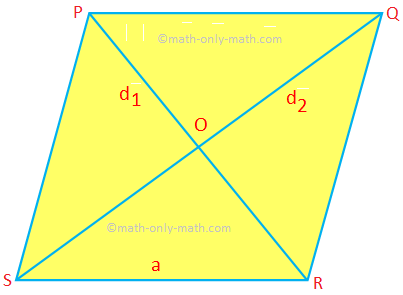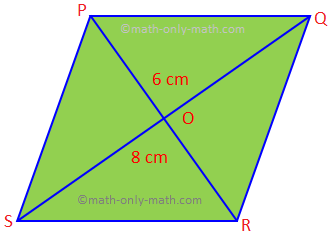Subscribe to our ▶️ YouTube channel 🔴 for the latest videos, updates, and tips.
Perimeter and Area of Rhombus
Here we will discuss about the perimeter and area of a rhombus and some of its geometrical properties.
Perimeter of a rhombus (P) = 4 × side = 4a
Area of a rhombus (A) = \(\frac{1}{2}\) (Product of the diagonals)
= \(\frac{1}{2}\) × d\(_{1}\) × d\(_{2}\)
Some geometrical properties of a rhombus:
In the rhombus PQRS,
PR ⊥ QS, OP = OR, OQ = OS,
PQ\(^{2}\) = OP\(^{2}\) + OQ\(^{2}\)
QR\(^{2}\) = OQ\(^{2}\) + OR\(^{2}\)
RS\(^{2}\) = OR\(^{2}\) + OS\(^{2}\)
SP\(^{2}\) = OS\(^{2}\) + OP\(^{2}\)
Solved Example Problem on Perimeter and Area of Rhombus:
1. The diagonals of a rhombus measure 8 cm and 6 cm. Find the area and the perimeter of the rhombus.
Solution:
In the rhombus PQRS, QS = 8 cm and PR = 6 cm.
Then, area of the rhombus = \(\frac{1}{2}\) × d\(_{1}\) × d\(_{2}\)
= \(\frac{1}{2}\) × QS × PR
= \(\frac{1}{2}\) × 8 × 6 cm\(^{2}\)
= 24 cm\(^{2}\)
Now, OP = \(\frac{1}{2}\) PR = \(\frac{1}{2}\) × 6 cm = 3 cm and,
OQ = \(\frac{1}{2}\) QS = \(\frac{1}{2}\) × 8 cm = 4 cm.
Also, ∠POQ = 90°.
So by Pythagoras’ theorem, PQ\(^{2}\) = OP\(^{2}\) + OQ\(^{2}\)
= (3\(^{2}\) + 4\(^{2}\)) cm\(^{2}\)
= (9 + 16) cm\(^{2}\)
= 25 cm\(^{2}\)
Therefore, PQ = 5 cm
Therefore, perimeter of a rhombus (P) = 4 × side
= 4 × 5 cm
= 20 cm
From Perimeter and Area of Rhombus to HOME PAGE
Didn't find what you were looking for? Or want to know more information about Math Only Math. Use this Google Search to find what you need.




New! Comments
Have your say about what you just read! Leave me a comment in the box below. Ask a Question or Answer a Question.